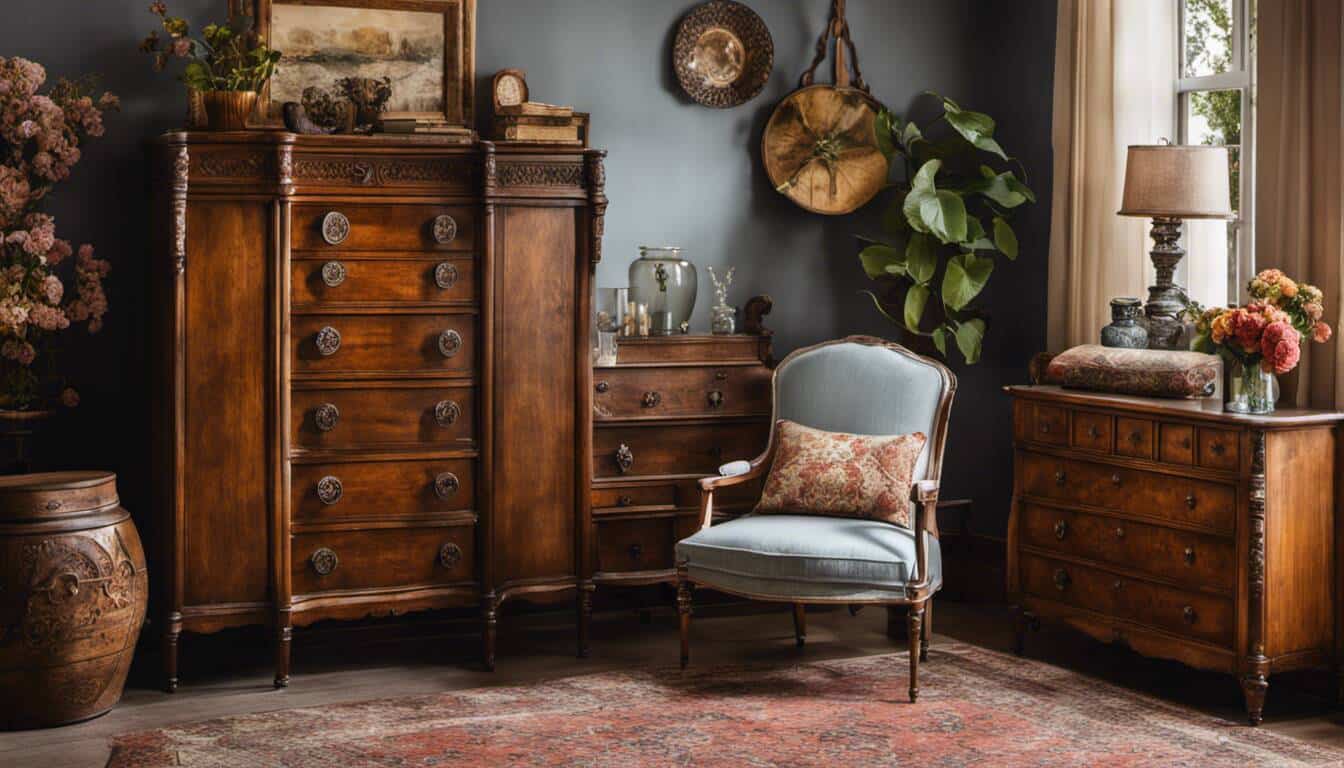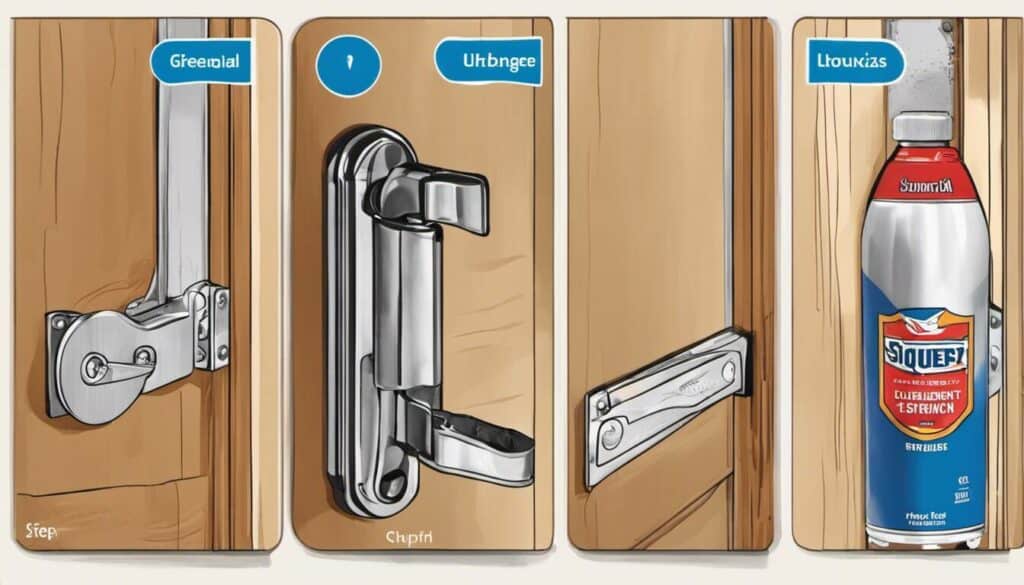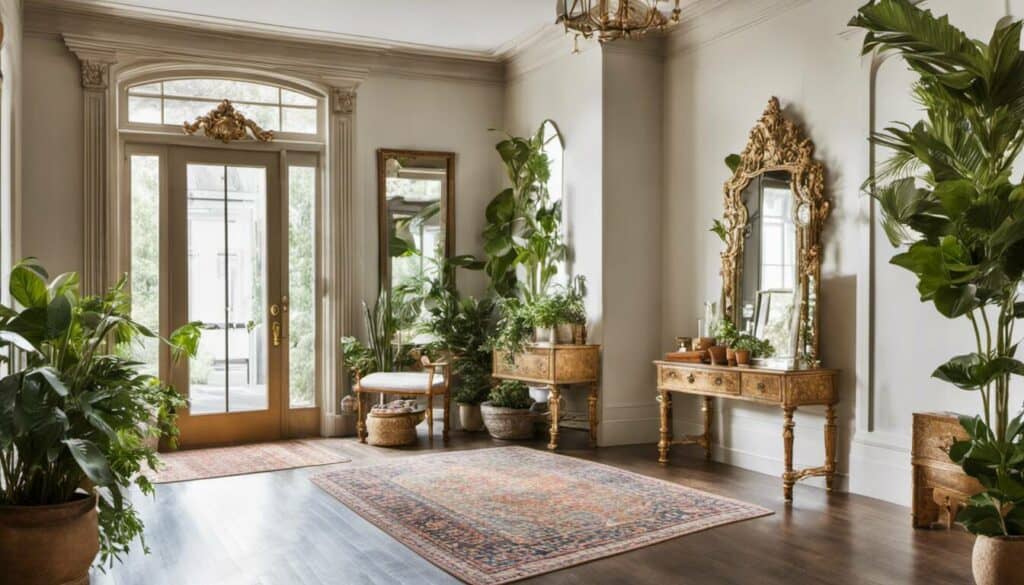The timeless charm of vintage furniture often paints a picture of needing deep pockets to afford them for your home. But from my own experience, that’s not necessarily the case. Let me share my findings and experiences, exploring where to find bargains and revealing tips to discover affordable pieces that bring character to your home!
Our “My Thrifty Vintage Furniture Finds” article shares one individual’s personal experience seeking out and acquiring affordable, high-quality vintage furniture. Readers can expect to learn about the process of finding great deals, common challenges encountered during this process, and tips for getting the most out of their own thrifty vintage furniture shopping experiences.
“True vintage furniture pieces narrate a story, flaunt unique craftsmanship, and possess an irreplaceable history. To score a truly valuable piece, delve not only into its aesthetics but also its origin, its previous owners, and its overall condition. Trust me, the true value of vintage isn’t purely in its looks, but the backstory that harmoniously hums with it.”
Viscount Sebastian LeGrange, Vintage Furniture Connoisseur
The Thrill of Thrifty Hunting
There’s something exhilarating about embarking on a thrifty hunting expedition in search of hidden treasures for your home décor. The anticipation of stumbling upon a unique vintage piece at an unbelievably affordable price creates a sense of excitement that can hardly be matched by traditional furniture shopping experiences. It’s like embarking on a treasure hunt, not knowing what gems you might uncover along the way. Whether you’re an avid vintage enthusiast or simply looking to add character to your living space, thrifting for furniture can be a thrilling adventure that allows you to express your personal style while staying within budget.
Imagine walking into a thrift store and spotting an old wooden cabinet tucked away in a corner, its intricate carvings catching your eye. Your heart races with excitement as you realize this could be the perfect statement piece for your living room, perhaps even a home for your living room plant. The thrill of finding such a unique item and imagining its potential in your home is what makes thrifty hunting so exciting.
Now that we’ve explored the thrill of thrifty hunting let’s dive into some pro tips to make your bargain hunts successful and rewarding.
Pro Tips for Successful Bargain Hunts
Thrifty hunting requires strategy and knowledge to find those retro bargains that will elevate your home decor without breaking the bank. Here are some pro tips to guide you on your journey:
- Research, Research, Research: Before heading out, research the best places in your area for vintage furniture and home decor. Check out local thrift stores, estate sales, online marketplaces, and antique shops. By doing your homework, you’ll have a better idea of where to find the best deals.
- Patience is Key: Vintage finds may not reveal themselves immediately, so be prepared to spend some time searching. Visit thrift stores regularly, as new items are constantly being added. The more patient and persistent you are, the higher the chances of stumbling upon a true gem.
- Inspect and Test: When you come across a potential piece, take your time to inspect it thoroughly. Check for any damage or wear and tear that may require costly repairs. Lift and test the furniture to assess its sturdiness and overall quality. Trust your instincts and only invest in pieces that meet your standards.
- Negotiate with Confidence: Don’t be afraid to negotiate the price, especially if you notice any flaws or imperfections. Bargaining is part of the thrifty hunting game, and many sellers are open to reasonable offers. Be respectful and polite but firm in your negotiations.
- Embrace DIY: Remember that vintage pieces often have great bones but may need some TLC. Don’t shy away from reupholstering, repainting, or restoring furniture yourself. With a little creativity and effort, you can transform an outdated piece into a stunning addition to your home.
By following these pro tips, you’ll be well-equipped to embark on successful bargain hunts, uncovering unique retro treasures that will add charm and personality to your home decor.
- What affordable vintage furniture items can I find and where can I find them?
- Three interesting statistics revolving around thrifty vintage furniture finds are:
- The global luxury furniture market was valued at around $26,937.7 million in 2020 and is projected to grow at a CAGR of approximately 4.22% from 2021 to 2027 (Source: MarketWatch), indicating a growing market for high-end resale and vintage furniture pieces.
- A study by Grand View Research estimates that the resale market would reach $64 billion by 2024, with an increasing percentage being in-home decor and furniture.
- Statista reports show that roughly 14% or 17.5 million people in the US alone purchased second-hand home accessories or furniture in spring 2017; emphasizing widespread preference for vintage furniture.
Vet Your Vintage: Recognizing Quality
When it comes to scoring retro bargains for your home décor, it’s crucial to vet your vintage and recognize quality. Thrift stores and estate sales are treasure troves of unique finds, but not all pieces are created equal. To ensure you bring home furniture that will stand the test of time, it’s essential to assess its quality.
One way to recognize quality is by lifting and testing the weight of the furniture. Well-constructed vintage pieces tend to be heavier as they were made with durable materials like solid wood or sturdy metal frames. Lighter pieces may indicate lower quality or use of cheaper materials. Additionally, inspect the joints and construction of the furniture for any signs of wobbliness or instability. A well-made piece will have sturdy joints that fit together seamlessly.
For example, let’s say you stumble upon a vintage Chromcraft chair at a thrift store. You lift the chair and notice its weightiness, indicating that it’s likely made from substantial materials. As you examine the chair closely, you also observe the clean and secure joints, ensuring its stability and durability. This could be a perfect addition to your space after you’ve finished decluttering your closet to make room for new finds.
It’s also important to check for any damage or wear on vintage furniture. Minor scratches or dings can be easily repaired or overlooked if they don’t affect the overall structure or aesthetic appeal. However, be cautious of major damage such as deep cracks or warping, as these issues may be more challenging (and costly) to fix.
By taking the time to carefully vet your vintage finds and recognizing quality, you can ensure that your retro bargains not only bring charm and character into your home décor but also withstand the test of time.
Decoding Styles: Mid-Century to Shabby Chic
Once you’ve mastered how to recognize quality in vintage furniture, it’s time to delve into decoding different styles. Vintage furniture encompasses an array of design aesthetics, each with its own unique characteristics and appeal. Two popular styles that often catch the eye are mid-century and shabby chic.
Mid-century furniture refers to pieces that were designed and produced during the mid-20th century, roughly between the 1930s and 1960s. This style is characterized by clean lines, organic shapes, and minimalist yet functional designs. Think sleek teak sideboards, Eames lounge chairs, and tulip dining tables. Mid-century furniture exudes a timeless appeal that seamlessly integrates into various interior design styles.
On the other hand, shabby chic embraces a more romantic and vintage-inspired aesthetic. It draws inspiration from the charming cottages of England with an emphasis on distressed finishes, pastel colors, floral motifs, and feminine details. Shabby chic furniture often features ornate carvings, soft curves, and antique hardware. This style exudes a cozy and nostalgic atmosphere reminiscent of simpler times.
Let’s say you visit a thrift store and stumble upon a stunning vanity adorned with intricate carvings. The wood grain has weathered over time, giving it a slightly distressed appearance. As you gaze at it, you notice a face-like pattern in the wood grain – a unique feature that adds character to the piece. You envision painting this vanity selectively to enhance its charm while preserving its vintage essence – a perfect example of blending shabby chic with your personal touch.
Where to Scout for Retro Treasures
If you’re on the hunt for unique vintage furniture pieces to give your home decor that retro flair, there are various places you can scout for these treasures. Physical stores, online marketplaces, and even flea markets can be great sources of thrifty finds.
Physical Stores: When it comes to physical stores, antique shops and vintage boutiques are worth exploring. These establishments often curate a selection of one-of-a-kind items that can add character and charm to your home. You might stumble upon a beautifully crafted midcentury modern chair or a funky vintage lamp that perfectly complements your space.
Online Marketplaces: The digital age has opened up an array of opportunities for vintage furniture enthusiasts. Online marketplaces like Etsy, eBay, and One Kings Lane offer convenient platforms where buyers can connect with sellers from all over the world. From antique bed frames to retro side tables, you’ll find an extensive range of offerings just a few clicks away.
Now that we know where to scout for retro treasures, let’s explore how to navigate both physical stores and online marketplaces effectively.
Navigating Physical Stores and Online Marketplaces
When it comes to searching for vintage furniture, each avenue – physical stores and online marketplaces – comes with its own set of considerations.
Physical Stores: Visiting physical stores allows you to personally examine and engage with the furniture pieces. You can assess their quality, test functionality, and get a better sense of their size and scale. Take advantage of detailed photos and descriptions provided by dealers to have a clear idea of what to expect. It’s advisable to focus on tables and case goods as they usually have detailed photos that showcase their quality and finish.
For example, imagine you come across a beautiful antique dresser in a local store. You can closely inspect its craftsmanship, feel the smoothness of the wood, and check for any damage or repairs. Being able to tangibly assess the condition of the furniture gives you a better chance of making an informed decision.
Online Marketplaces: Shopping for vintage furniture online offers convenience and a vast selection. However, it’s crucial to pay attention to details and ask relevant questions before making a purchase. Reach out to sellers for detailed measurements, specifics about comfort and cushion types for upholstered pieces, and even additional photos if needed. Return policies can vary among dealers, so make sure to inquire about them beforehand.
Let’s say you find a unique retro sofa on an online marketplace. Take note of the provided measurements and compare them with your available space at home. You might also want to ask the seller about the level of comfort, the type of cushioning used, and the angle of the backrest. The more information you gather, the more confident you can be in your decision.
Whether you’re exploring physical stores or venturing into online marketplaces, having some knowledge about different styles and eras of vintage furniture can be invaluable. It allows you to recognize the potential value and authenticity of a piece while enhancing your overall shopping experience.
Revamping Vintage: A DIY Guide
There’s something undeniably charming about stumbling upon a hidden gem at a thrift store or flea market. The allure of vintage furniture and home décor is not just its affordability but the unique character it brings to your space. With a bit of creativity and some elbow grease, you can revamp these treasures into stunning pieces that reflect your personal style. But where do you start with this DIY journey?
Let’s begin with one of the most important steps in revamping vintage furniture – cleaning and prepping the piece. Vintage finds often come with layers of dust, grime, and sometimes even mildew. Giving them a thorough clean will reveal their true potential. Use gentle cleansers appropriate for the material, such as wood polish for wooden pieces or delicate fabric cleaners for upholstery.
Once your piece is clean, assess its condition for any repairs that may be needed. It could be loose joints, broken hardware, or chipped paint. Fixing these issues before undertaking any aesthetic changes is essential to ensure the durability and functionality of your revamped vintage piece.
Now comes the fun part – deciding on a design direction for your revamped vintage find. Do you want to restore it to its original glory or give it a modern twist? This decision will guide your choices in terms of paint colors, finishes, and upholstery fabrics.
Next, gather the necessary supplies for refinishing or repainting your vintage piece. Sandpaper, primer, paintbrushes, and high-quality paints are some essentials to have on hand. Research different techniques like distressing or color-blocking to achieve the desired effect.
Once you’ve finished revamping your vintage furniture with a fresh coat of paint or restored its original beauty, another question arises: To Paint or Not? Let’s explore the aesthetic choices when it comes to renovating vintage pieces.
To Paint or Not: Aesthetic Choices in Renovation
When faced with a stunning vintage piece, the decision to paint or preserve its original aesthetic can be a challenging one. On one hand, painting allows you to completely transform the look and feel of the furniture to match your style and décor. On the other hand, preserving the original finishes and wood grain maintains its authenticity and historical value.
Consider the overall condition of the piece. If the wood is damaged or the finish is worn off, painting can be an excellent way to give it new life while hiding imperfections. It also opens up a world of color possibilities, allowing you to create a unique statement piece that stands out in any room.
However, if the vintage find is in pristine condition with beautiful wood grain and original hardware, you may want to think twice before reaching for that paintbrush. Sometimes, embracing the natural beauty of an item can enhance its charm and aesthetic appeal.
Imagine stumbling upon a beautifully crafted wardrobe with intricate woodwork and a warm natural finish. Painting it might hide those exquisite details and diminish its timeless elegance. In this case, opting for minimal restoration like refinishing or adding a protective coat might be the best choice.
Ultimately, the decision to paint or not comes down to personal preference and how you envision incorporating the piece into your home décor. Whether you choose to revamp it with bold colors or preserve its original character, remember that vintage furniture holds stories within them, waiting to be cherished anew.






Decorating homes with vintage pieces is always an adventure. Once, I stumbled upon an antique Victorian bureau in a small thrift store, which turned out to be the highlight of my entire sale! Sometimes, one man’s trash really can become another man’s treasure.
Couldn’t agree more, Zinnia! Speaking from experience, I once found an old teak vanity table, quite battered and forgotten at the corner of a thrift store. With just a little elbow grease and love, I was able to restore it to its former glory! Now it’s my prized possession.
It’s amazing how some TLC can bring back a piece from the brink, isn’t it Lyndon? I once stumbled upon a seemingly worthless broken Windsor chair, but with careful restoration, it became an eye-catching center of attention in my client’s living room!
Indeed Sylvester, it’s astounding what a bit of care can achieve. I once found an old, tired-looking roll-top desk at my local thrift store that everyone else had dismissed. With patience and several weeks hard work, it emerged from its chrysalis like a butterfly, its natural wood glowing under layers of wax. Restoration brings not only the furniture back to life but adds value to our lives as well by providing immense satisfaction and a sense of accomplishment.
Terrence, I resonate with your sentiment on the level of gratification derived from restoration. There’s nothing like breathing life back into an underrated treasure. That transformation from ‘dismissed’ to ‘admired’ is such a captivating process—it unfolds as our very own personal narrative etched on the canvas of woodwork.